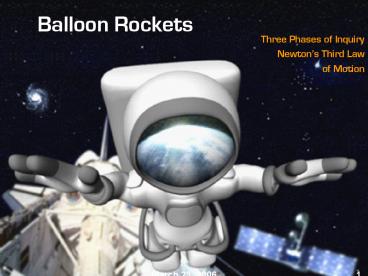Balloon Rockets - PowerPoint PPT Presentation
1 / 17
Title:
Balloon Rockets
Description:
Is it possible to create a balloon rocket that will travel from ... there is an equal and opposite reaction') to take us to the Moon and beyond. ... – PowerPoint PPT presentation
Number of Views:1364
Avg rating:3.0/5.0
Title: Balloon Rockets
1
Balloon Rockets
- Three Phases of Inquiry
- Newtons Third Law
- of Motion
2
Activity 1
Is it possible to create a balloon rocket that
will travel from Point A to Point B following
these precise instructions?
3
Your Mission
- Aerospace engineers apply Newtons Third Law (to
every action there is an equal and opposite
reaction) to take us to the Moon and beyond.
With this project, you become the aerospace
engineer, designing and building a balloon rocket
to travel the desired distance in the fastest
time.
4
- Materials
- Tape
- Balloon
- Straw
- Scissors
- Fishing Line
- Instructions
- Thread the straw onto the fishing line.
- Secure end of fishing line to instructed
position. Line must be taut. - Put a piece of tape over the straw.
- Blow up the balloon---hold the mouth part closed
so air doesnt escape. - Stick the balloon to the tape.
- Wait for launch instructions.
Your subtopic goes here
- Your subtopic goes here
- Your subtopic goes here
- Your subtopic goes here
5
Prepare for launch!!!
- Predict what will happen when you release the
neck of the balloon and how far the balloon will
travel.
6
Blast off!!!!!!!
7
Activity 2
Is it possible to create a balloon rocket that
will travel from Point A to Point B by changing
only one variable?
8
What happened?
- Develop I Wonder Questions
- Choose a variable that your team would like to
change to help your rocket achieve its mission.
You may use any of the supplies. - Incorporate changes.
- Prepare for next launch.
- Record predictions.
- Share your plan with other teams.
9
Blast off!!!!!!!
10
What have you observed?
- All teams need to report out.
- As a team, think about what you are learning from
others that can help you complete this mission.
11
Activity 3
Design the ultimate balloon rocket that will
travel the route in the fastest time. You may
employ any means necessary to complete your
mission.
12
Blast off!!!
13
As a team, reflect on these questions
- How did your teams rocket perform?
- What are the parts of the rocket?
- What parts were changed and why?
- What difference did it make when you changed
- the balloon?
- the line?
- the straw?
- other?
- What questions do you still have?
14
Switching Back to the Teacher Hat
- Compare Activities 1, 2, 3 with respect to who
supplies - - the question
- - the methods/procedures
- - the results based on the evidence?
15
How much information does the teacher give to
the student?
16
How much information does the teacher give to
the student?
17
Levels of Inquiry
- Continuum of Inquiry-Based Teaching
- Structured Inquiry Guided Inquiry
Open Inquiry - .
Teacher poses an investigable question and
provides the procedure. Students investigate
and make evidence-based explanations.
Teacher poses an investigable question.
Students determine the procedure for the
investigation and make evidence-based
explanations.
Teacher selects topic. Students generate an
investigable question and determine the procedure
for the investigation. Students make
evidence-based explanations.
18
Our Take Home Message
- All approaches to hands-on science are not
alikeeach approach has distinguishable
characteristics. - Different approaches to hands-on science have
different objectives for learning. - The different approaches to hands-on science
should be matched to your learning goals.

